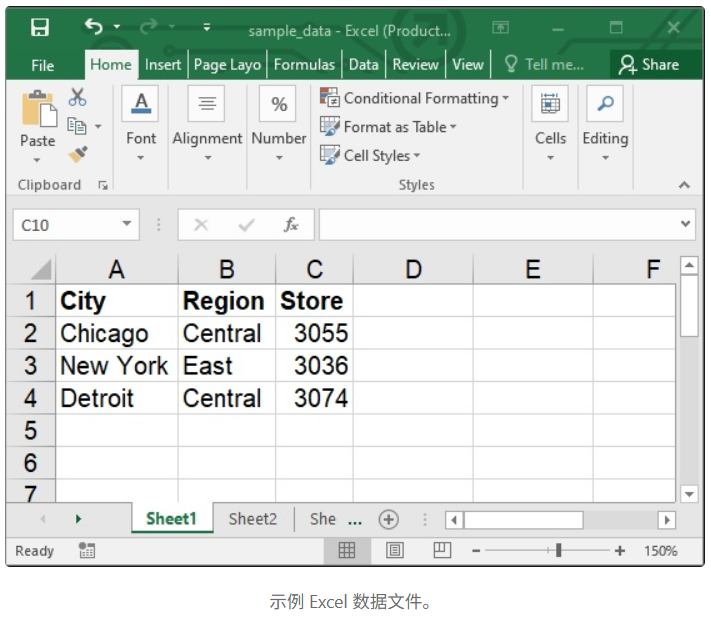Excel處理控件Aspose.Cells教程:如何將Excel區域轉換為Python列表

在 Python 中處理 Excel 數據通常需要將特定的行和列提取為列表格式。將 Excel 范圍轉換為 Python 列表對于以下任務非常有用:
- 使用Pandas和NumPy進行數據分析
- 報告和 ETL 流程的自動化
- 與機器學習模型或 API 集成
在本教程中,我們將逐步學習如何借助Aspose.Cells在 Python 中將定義的 Excel 范圍轉換為列表。
Aspose.Cells官方試用版免費下載,請聯系Aspose官方授權代理商慧都科技
加入Aspose技術交流QQ群(1041253375),與更多小伙伴一起探討提升開發技能。
Python Excel 到列表轉換庫
開發人員無需手動解析 Excel 文件,而是可以使用 Aspose.Cells for Python via .NET(一個功能強大的 Excel 到列表轉換庫)。它不僅可以更輕松地將范圍、行和列提取到 Python 列表中,還支持公式、格式、圖表和數據透視表等高級功能,即使在復雜的電子表格中也能確保準確性。
在編碼之前,請確保您的設置已準備就緒:
- 安裝Python 3.7+。
- 從發行版下載 Aspose.Cells或使用 pip 安裝:
pip install aspose-cells-python - sample_data.xlsx準備一個包含以下內容的示例 Excel 文件( ):
![]()
Aspose.Cells官方試用版免費下載,請聯系Aspose官方授權代理商慧都科技
加入Aspose技術交流QQ群(1041253375),與更多小伙伴一起探討提升開發技能。
將 Excel 范圍轉換為 Python 列表:分步指南
讓我們了解使用 Aspose.Cells for Python 將一系列 Excel 數據轉換為 Python 列表的過程。
按照以下步驟將 Excel 范圍轉換為 Python 中的列表:
- 首先,使用該類加載現有的 Excel 文件Workbook。
- 其次,獲取第一個工作表。
- 接下來,創建一個范圍,例如 A1 到 C4。
- 之后,將 Range 轉換為 Python List。
- 最后,打印列表。
以下 Python 腳本加載 Excel 文件,定義范圍并將其轉換為 Python 列表。
from aspose.cells import Workbook
# Step 1: Load the Excel workbook
book = cells.Workbook("sample_data.xlsx")
# Step 2: Access the first worksheet
sheet1 = book.worksheets.get(0)
# Step 3: Define the range (A1:C4 in this example)
sheet_cells = sheet1.cells
range_obj = sheet_cells.create_range("A1", "C4")
# Step 4: Convert the range into a nested Python list
range_list = []
for row_index in range(range_obj.first_row, range_obj.first_row + range_obj.row_count):
row = []
for column_index in range(range_obj.first_column, range_obj.first_column + range_obj.column_count):
curr_cell = sheet_cells.check_cell(row_index, column_index)
row.append(curr_cell.value if curr_cell else "")
range_list.append(row)
# Step 5: Print the Python list
print("Python List Output:")
print(range_list)輸出
Python List Output:
[['City', 'Region', 'Store'], ['Chicago', 'Central', 3055], ['New York', 'East', 3036], ['Detroit', 'Central', 3074]]此完整腳本演示了如何從 Excel 中提取數據并將其轉換為 Python 列表。之后,您可以根據需要輕松地將其轉換為 Pandas 或 JSON。
將 Python 列表轉換為 Pandas DataFrame
使用 Pandas,您可以直接將列表轉換為 DataFrame:
import pandas as pd
# Convert to a Pandas DataFrame
df = pd.DataFrame(range_list[1:], columns=range_list[0])
print(df)Pandas DataFrame 輸出:
City Region Store
0 Chicago Central 3055
1 New York East 3036
2 Detroit Central 3074將 Python 列表保存為 JSON
您還可以將數據導出為 JSON:
import json
# Convert to JSON
json_output = json.dumps(range_list)
print(json_output)JSON 輸出:
[["City", "Region", "Store"], ["Chicago", "Central", 3055], ["New York", "East", 3036], ["Detroit", "Central", 3074]]在 Python 中將 Excel 行轉換為列表
有時您可能只想從 Excel 中提取一行并將其存儲為列表。以下是使用 Aspose.Cells 的操作方法:
- 加載 Excel 工作簿。
- 訪問目標工作表。
- 通過索引選擇行。
- 將行值收集到 Python 列表中。
# Import Aspose.Cells library
from aspose.cells import Workbook
# Step 1: Load the Excel workbook from file
book = Workbook("sample_data.xlsx")
# Step 2: Access the first worksheet in the workbook
sheet = book.worksheets.get(0)
# Step 3: Define the row index (0 = first row, which contains headers)
row_index = 0
cells = sheet.cells
# Create a range object for the selected row
row_range = cells.create_range(row_index, 0, 1, sheet.cells.max_column + 1)
# Step 4: Convert the row into a Python list
row_list = []
for column_index in range(row_range.first_column, row_range.first_column + row_range.column_count):
curr_cell = cells.check_cell(row_index, column_index) # Get each cell in the row
row_list.append(curr_cell.value if curr_cell else "") # Append value or empty string if cell is blank
# Print the extracted row as a list
print("Row to List:", row_list)輸出:
Row to List: ['City', 'Region', 'Store']使用 Python 將 Excel 列轉換為列表
您還可以將單列提取到列表中。例如,我們將“Region”列轉換為列表:
- 加載工作簿和工作表。
- 通過索引選擇列。
- 遍歷列中的每一行。
- 將列值收集到列表中。
# Import Aspose.Cells library
from aspose.cells import Workbook
# Step 1: Load the Excel workbook from file
book = Workbook("sample_data.xlsx")
# Access the first worksheet in the workbook
sheet = book.worksheets.get(0)
# Step 2: Define the column index (0 = first column, i.e., Column A)
col_index = 0
cells = sheet.cells
# Create a range object for the selected column
# Parameters: (start_row, start_column, total_rows, total_columns)
# Here, start at row 0, select col_index, include all rows, and width = 1 column
col_range = cells.create_range(0, col_index, sheet.cells.max_row + 1, 1)
# Step 3 & 4: Convert the column into a Python list
col_list = []
for row_index in range(col_range.first_row, col_range.first_row + col_range.row_count):
curr_cell = cells.check_cell(row_index, col_index) # Get each cell in the column
if curr_cell: # Only add if the cell exists (ignore empty rows)
col_list.append(curr_cell.value)
# Print the extracted column as a list
print("Column to List:", col_list)輸出:
Column to List: ['City', 'Chicago', 'New York', 'Detroit']結論
我們演示了如何通過 .NET 使用 Aspose.Cells for Python 提取范圍、行和列,將 Excel 數據轉換為 Python 列表。轉換為列表后,數據可用于 Pandas、JSON 或其他處理任務。雖然 openpyxl 或 pandas.read_excel 等庫可以提取范圍,但 Aspose.Cells 能夠更好地控制公式、格式、圖表和合并單元格,使其成為復雜 Excel 操作的更佳選擇。
Aspose.Cells官方試用版免費下載,請聯系Aspose官方授權代理商慧都科技
加入Aspose技術交流QQ群(1041253375),與更多小伙伴一起探討提升開發技能。

 在 Python 中處理 Excel 數據通常需要將特定的行和列提取為列表格式。在本教程中,我們將逐步學習如何借助Aspose.Cells在 Python 中將定義的 Excel 范圍轉換為列表。
在 Python 中處理 Excel 數據通常需要將特定的行和列提取為列表格式。在本教程中,我們將逐步學習如何借助Aspose.Cells在 Python 中將定義的 Excel 范圍轉換為列表。


 浙公網安備 33010602011771號
浙公網安備 33010602011771號